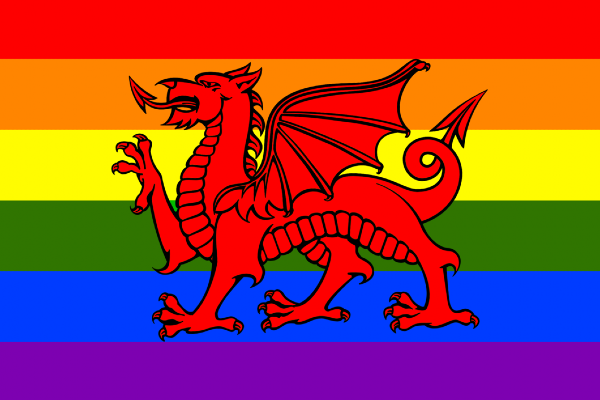 Dydd Gwyl Dewi Hapus / Happy St. David’s Day to everyone celebrating today!
Dydd Gwyl Dewi Hapus / Happy St. David’s Day to everyone celebrating today!
What is the Welsh national day all about? Learn a bit more about who St. David was below
 David was born in the 6th century. The exact date of his birth is unknown, but David is said to have been born around the year 520 – some 1,500 years ago. He was reputedly born on the Pembrokeshire cliffs during a wild thunderstorm. Story has it that David was the son of Sant (aka Sanctus), king of Ceredigion and a nun named Nonnita (Non).
David was born in the 6th century. The exact date of his birth is unknown, but David is said to have been born around the year 520 – some 1,500 years ago. He was reputedly born on the Pembrokeshire cliffs during a wild thunderstorm. Story has it that David was the son of Sant (aka Sanctus), king of Ceredigion and a nun named Nonnita (Non).
As a young man, David became a monk. He is said to have founded a monastery in around the year 560, close to the place where he was born. The surrounding area (in Pembrokeshire, west Wales) is now known simply as ‘St Davids’. It’s believed that St Davids Cathedral and St Davids Bishop’s Palace are built on the site of the original monastery.
 Britain’s smallest city is named after him. The existence of the cathedral means that St Davids is Britain’s smallest city, with a population of roughly 1,600 – compared to an estimated 358,000 in Wales’s capital, Cardiff. The tenor Dewi Sant bell in the cathedral weighs 2,700lbs!
Britain’s smallest city is named after him. The existence of the cathedral means that St Davids is Britain’s smallest city, with a population of roughly 1,600 – compared to an estimated 358,000 in Wales’s capital, Cardiff. The tenor Dewi Sant bell in the cathedral weighs 2,700lbs!
David became known as Dewi Dyfrwr (‘David the Waterdrinker’) because of his modest monk’s diet of bread and water. Even meat and beer were forbidden.
According to legend, David was a miracle maker: he was said to have been able to restore a blind man’s sight and bring a child back to life by splashing the boy’s face with tears. While preaching to a crowd in the village of Llanddewi Brefi, David is thought to have performed his most famous miracle: some of the crowd were finding it difficult to hear the sermon, when a white dove landed on David’s shoulder. As it did, the ground on which he stood is said to have risen up to form a mighty hill, making it possible for the gathering crowd to finally see and hear him. The dove became St David’s emblem, often appearing in his portraits and on stained-glass windows depicting him. Today, a church stands on the crest of the special hill.
 St David’s influence was not limited to Wales – churches and chapels dedicated to David can also be found in south-west England, Ireland and Brittany.
St David’s influence was not limited to Wales – churches and chapels dedicated to David can also be found in south-west England, Ireland and Brittany.
David’s final words to his followers were supposedly: “Do the little things, the small things you’ve seen me doing” or “Do the little things that you have heard and seen me do”.
After St David’s death, a shrine was built in his honour at his cathedral. Pope Callistus II thought of it so highly that he declared to Catholics that two pilgrimages to the shrine was worth one to the Vatican in Rome. By the 12th century, more than 60 churches in Wales had also been dedicated to St David.
 After his 1284 military campaign in Wales, English king Edward I took the head and arm of St David from the cathedral and displayed the remains in London.
After his 1284 military campaign in Wales, English king Edward I took the head and arm of St David from the cathedral and displayed the remains in London.
The nickname ‘Taffy’ for a Welshman links back to St David as the original and ultimate Welshman – the term dates to the 17th century and derives from ‘Dafydd’, the Welsh for David.
 William Shakespeare name-dropped St David in Henry V. When Fluellen’s English colleague, Pistol, insults the humble leek on St David’s Day, Fluellen insists he eat the national emblem as punishment: “If you can mock a leek, you can eat a leek” (Act V, Scene I).
William Shakespeare name-dropped St David in Henry V. When Fluellen’s English colleague, Pistol, insults the humble leek on St David’s Day, Fluellen insists he eat the national emblem as punishment: “If you can mock a leek, you can eat a leek” (Act V, Scene I).
Schools across Wales hold celebrations, with a number of children dressing in traditional costume – a black hat with white trim; long skirts and shawls or a Welsh rugby or football shirt. Schools across the country will also hold an Eisteddfod (a traditional festival of Welsh poetry and music) on this day.

















You must be logged in to post a comment.